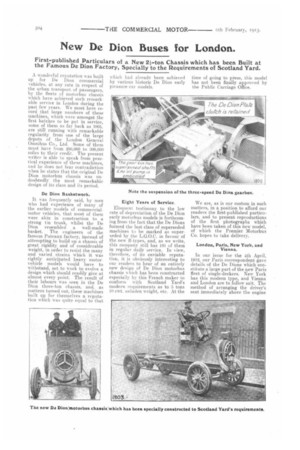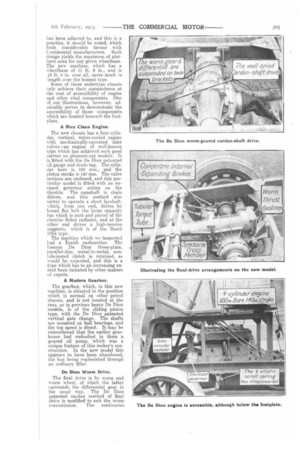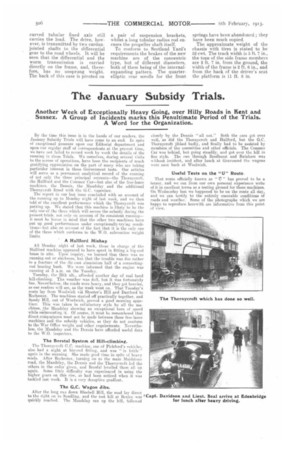New De Dion Buses for London.
Page 18

Page 19

Page 20

If you've noticed an error in this article please click here to report it so we can fix it.
First-published Particulars of a New 2i-ton Chassis which has been Built at the Famous De Dion Factory, Specially to the Requirements of Scotland Yard.
A wonderful reputation was built up for De Dion commercial vehicles, at any rate in respect of the urban transport. of passengers, by the fleets of mot orbus chassis which have achieved such remarkable service in London during the past few years. We must here record that large numbers of these machines, which were amongst the first batches to be put in service, some of them as far back as 1905, are still running with remarkable regularity from one of the large depots of the London General Omnibus Co., Ltd. Some of them must have from 2n0,000 to 300,000 miles to their credit. The present writer is able to speak from practical experience of these machines, and he does not fear contradiction when he states that the original De Dion motorbus chassis was undoubtedly the most remarkable design of its class and Is period.
De Dion Basketwork.
It was frequently said, by men who had experience of many of the earlier models of commercialmotor vehicles, that most of them were akin in construction to a strong tin trunk, whilst the De Dion resembled a well-made basket. The engineers of the famous Puteaux factory, instead of attempting to build up a chassis of great rigidity and of considerable weight, in order to resist the many and varied strains which it was rightly anticipated heavy motorvehicle models would have to withstand, set to work to evolve a design which should readily give at almost every point. The result of their labours was seen in the De Dion three-ton chassis, and, as matters turned out, these machines built up for themselves a reputation which was quite equal to that
which had already been achiever] by various historic De Dion early pleasure car models.
Eight Years of Service.
Eloquent testimony to the low rate of depreciation of the De Dion early motorbus models is forthcoming from the fact that the De Dions formed the last class of superseded machines to be marked as superseded by the L.G.O.C. in favour of the new B-types, and, as we write, this company still has 101 of them in regular daily service. In view, therefore, of its enviable reputation, it is obviously interesting to our readers to hear of an entirely new design of De Dion motorbus chassis which has been constructed especially by this French maker to conform with Scotland Yard's modern requirements as to 3 tons 10 cwt. unladen weight, etc. At the time of going to press, this model has not been finally approved by the Public Carriage Office.
We are, as is our custom in such matters, in a position to afford our readers the first-published particulars, and to present reproductions of the first photographs which have been taken of this new model, of which the Premier Motorbus Co. hopes to take delivery.
London, Paris, New York, and Vienna.
In our issue for the 4th April, 1912, our Paris correspondent gave details of the De Dions which constitute a large part of the new Paris fleet of single-deckers. New York has this modern type, and Vienna and London are to follow suit. The method of arranging the driver's seat immediately above the engine has been adhered to, and this is a practice, it should be noted, Which finds considerable favour with Continental manufacturers. Such design yields the maximum of platform area for any given wheelbase. The new machine, which has a wheelbase of 11 ft. 8 in., and is 18 ft. 8 in. over all, saves much in length over the bonnet type.
Some of these undertype chassis only achieve their compactness at the cost of accessibility of engine and other vital components. One of our illustrations, however, admirably serves to demonstrate the acceSsibility of those components which are located beneath the footplate.
A Nice Clean engine.
The new chassis has a four-cylinder, vertical, water-cooled engine with mechanically-operated inlet valves—an engine of well-known type which has achieved such good service on pleasure-car models. It is fitted with the De Dion patented oil gauge and drain tap. The cylinder bore is 100 mm., and the piston stroke is 140 mm. The valve motions are enclosed, and this particular model is fitted with an encased gorvernor acting on the throttle. The camshaft is chain driven, and this method also serves to operate a short layshaft, which, from one end, drives by broad flat belt the large capacity fan which is part and parcel of the circular SoIex radiator, and at the other end drives a high-tension magneto, which is of the Bosch DN4 type: The machine which we inspected had a Zenith carburetter. The famous De Dion three-plate, parallel-disc, metal-to-metal, nonlubricated clutch is retained, as would be expected, and this is a type which has to an increasing extent been imitated by other makers of repute.
A Modern Gearbox.
The gearbox, which, in this new machine, is situated in the position which is normal on other petrol chassis, and is not located at the rear, as in previous heavy De Dion models, is of the sliding pinion type., with the De Dion patented vertical gate change. The shafts are mounted on ball bearings, and the top speed is direct. It may be remembered that the earlier gearboxes had embodied in them a geared oil pump, which wa.s a unique feature of this maker's construction. In the new model this appears to have been abandoned, the box being replenished through an ordinary filler.
De Dion Worm Drive.
The final drive is by worm and worm wheel, of which the latter surrounds the differential gear in the usual way. The De Dion patented cardan method of final drive is modified to suit the worm transmission. The continuous
curved tubular fixed axle still carries the load. The drive, however, is transmitted by two cardanjointed shafts to the differential gear to the road wheels. It will be seen that the differential and the worm transmission is carried directly on the frame, and, therefore, has no unsprung weight. The back of this case is pivoted on pair of suspension brackets, whilst a long tubular radius rod encases the propeller shaft itself. To conform to Scotland Yard's requirements the brakes of the new machine are of the concentric type, but of different diameters, both of them being of the internalexpanding pattern. The quarterelliptic rear scrolls for the front springs have been abandoned ; they have been much copied.
The approximate weight of the chassis with tires is stated to be 52 cwt. The track width is 5 ft. 7 in., the tops of the side frame members are 2 ft. 7 in. from the ground, the width of the frame is 2 ft. 6 in., and from the back of the driver's seat the platform is lift. 8 in.






























